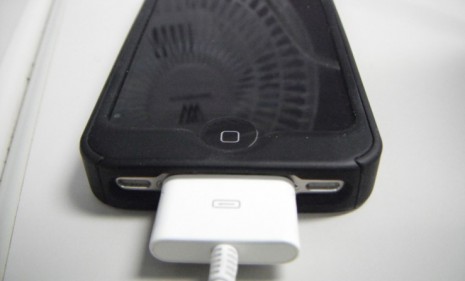Charging an iPhone... with your heartbeat
Scientists develop a tiny chip that uses body movement to generate power. Will batteries become redundant?

In the future, dancing the night away may be just as good a way to charge your iPhone as plugging it into a traditional outlet. That's because scientists have devised a way to power handheld electronic devices simply by flexing a tiny stack of microchips — something that could be achieved through the movement of a human body part or organ. Soon, they theorize, those chips could be implanted in your body, and your pumping heart could act as an effective battery. Here, a brief guide to the technology:
How is this possible?
For years, a group of Georgia scientists have been working with nanogenerators — tiny chips made of zinc-oxide wires that produce a buzz of electricity when stretched or strained. Until recently, these devices were capable of putting out less than one volt of energy, not enough to have any real-world application. But researchers have been able to drastically increase the chips' power, and a stack of them, one on top of another, can now produce three volts — equivalent to the power emitted by two double-A batteries.
The Week
Escape your echo chamber. Get the facts behind the news, plus analysis from multiple perspectives.

Sign up for The Week's Free Newsletters
From our morning news briefing to a weekly Good News Newsletter, get the best of The Week delivered directly to your inbox.
From our morning news briefing to a weekly Good News Newsletter, get the best of The Week delivered directly to your inbox.
And they'd put these in my heart?
Since the nanogenerators are so small, they can theoretically be embedded in almost anything — a piece of clothing, a shoe, or even... the human body. Five hundred wires are the width of a single human hair, so "it’s conceivable that you could have them implanted inside your body, so that, say, every time your heart beats you can power your handheld device," says Nicholas Deleon at CrunchGear.
When could this happen?
Researcher Zhong Lin Wang estimates that the first models (but sadly, not the heart implants) will be out in three to five years, according to an American Chemical Society press release. For now, he is focused on increasing the output of the devices, and finding a manufacturer to produce them commercially. "Our nanogenerators are poised to change lives in the future," he says. "Their potential is only limited by one's imagination."
A free daily email with the biggest news stories of the day – and the best features from TheWeek.com
Sources: Daily Mail, CrunchGear, Tech News Daily, American Chemical Society, MSNBC
-
 A luxury walking tour in Western Australia
A luxury walking tour in Western AustraliaThe Week Recommends Walk through an ‘ancient forest’ and listen to the ‘gentle hushing’ of the upper canopy
-
 What Nick Fuentes and the Groypers want
What Nick Fuentes and the Groypers wantThe Explainer White supremacism has a new face in the US: a clean-cut 27-year-old with a vast social media following
-
 5 highly amusing cartoons about rising health insurance premiums
5 highly amusing cartoons about rising health insurance premiumsCartoon Artists take on the ACA, Christmas road hazards, and more